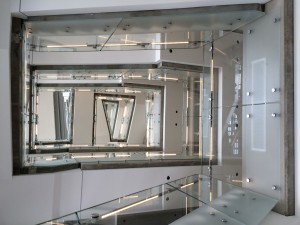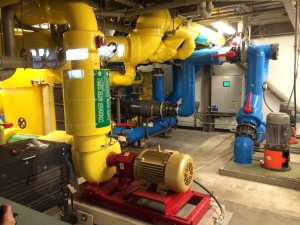Net Positive Energy + Water Conference
On February 4-5, 2014, the International Living Future Institute (ILFI) presented a fantastic series of events and speakers over two days in San Francisco, focusing on projects that are Net Zero in their energy and water use. As inspiration, the conference started with a tour of projects in San Francisco and the East Bay. The San Francisco tour included the new headquarters for the San Francisco Public Utilities Commission at 525 Golden Gate and the new Exploratorium located on a pier at the Embarcadero. Both these buildings are stunning and worth a visit.
The SF Public Utilities Commission building, a 13 story Class A office building of 277,500 square feet, has succeeded in reducing water consumption by over 60% using two strategies: harvesting rainwater (25,000 gallon cistern) for exterior landscaping irrigation, as well as reclaiming and treating 5,000 gallons of wastewater per day in its Living Machine. Planting along the building’s edge provides the filtering for the Living Machine. The water then goes into a series of wetlands for further treatment. Finally the water is disinfected with UV filtering and chlorine before being used in the low-flow toilets and urinals. This has resulted in a 5 gallon per day water use compared to the average office building use of 12 gallons per day. The solar array provides 7% of the buildings energy (with a tiny contribution made by the wind turbines, which are really more decorative than functional). Swirl diffusers in the raised flooring system, smart elevators, exterior blinds, and daylighting contribute as well to help the building use 32% less energy than a typical building of its size, with an Energy Use Intensity (EUI is energy used per square foot per year) calculated at around 35 kBtu/sq.ft.
The Exploratorium is a showpiece. At 240,000 square feet it is also the largest Net Zero energy building to date. Situated on a pier at the Embarcadero, it takes advantage of the best of what the site and original structure had to offer. A 1.2 magawatt PV array provides power for the building. (The seagulls, unfortunately, are very happy with the array and find it provides great nesting opportunities.) A hydronic slab heats and cools the building, drawing heat and cooling potential from the San Francisco Bay’s water, which is pumped up into the building in a closed-loop system, transferring its heating and cooling potential in a range of plus or minus three degrees. Displacement diffusers and a careful daylighting design help reduce energy needs. Rainwater is collected off the roof and stored in a cistern under the pier and is used for flushing toilets. Any surplus rainwater is filtered and returned to the bay. Supplemental water from the city supply is used for sinks, etc.
Denis Hayes was the featured speaker for the evening. He spoke about the Bullitt Center and how important it is to design efficient buildings for our cities, given the migration of the world’s population to urban centers. Performance is what matters, he noted. Build them to be efficient and to last. The US Drought Monitor map only emphasized this. He showed an image of the New College at Oxford, still doing its job 700 years later. He spoke about Earth Day 2014 and its Green Communities, focused on forming a community of shared values for a just and sustainable future.
Jason F. McLennan spoke to the group the following morning, emphasizing the goal of restorative projects that can move to a Net Positive future. He mentioned some beautiful projects, including the Omega Center, Hawaii Preparatory Academy, Tyson Living Center, CIRS, and the Sustainable Building Research Center. Countering the standard fear that green buildings look weird and are expensive, he argued the designer needs to provide a better solution to standard requirements. Make energy look, “fun, attractive, and interactive,” he suggests. He notes that when Walgreens builds a Net Zero store you know that it is the, “beginning of the end of the old paradigm.”
The day continued with three morning sessions, a riveting keynote speaker Maude Barlow at lunch, and three afternoon sessions. One of the morning sessions was entitled Lessons Learned from Net Zero Energy Certified Projects. Pauline Souza of WRNS Studio talked about her work designing the library at the Sacred Heart School in Atherton. Highlights include it being a PG&E Net Zero Pilot Project, achieving an EUI of 16.9, and adding no addition costs to gain Net Zero energy.
Dale Mikkelsen of Simon Fraser University then presented an inspirational project: UniverCity Childcare near Vancouver, BC. He stated his project’s goals to be the environment, equity, economy, and education. At an impressive 18% less per square foot construction cost than other pubic daycare projects, this center achieves an EUI of 20. The reduction in potable water use is 80%. The building presently is connected to city water, but the system is set up to use the water collected onsite once approved. Rainwater is used for janitor sinks, dishwasher, and laundry. The blackwater is treated onsite by a digester and the treated water is used for irrigation. A solar thermal system is on the roof and it provides 100% of the energy use, including domestic hot water and space heating. He noted that the building was creating surplus energy. He emphasized that this project becomes a beacon for future work is inspiring: it becomes teachable and repeatable. Not only is this project very successful in terms of energy and water use reduction, it is also wonderful to learn how the design team enlisted the kids who would be using the daycare center to help in the initial design charettes. Their ideas became key design elements of the final project.
Brad Jacobson of EHDD, the next speaker, presented the Packard Foundation in Los Altos. Some of the strategies used on this project include harvested water for toilets and irrigation, balanced daylighting design, advanced framing (24” on center, all FSC Certified wood), triple-pane windows, and chilled beams. The building has achieved net positive in energy. The PV array has produced more energy than predicted. Although the energy use is higher than was calculated through energy modeling – with more heating than predicted – there has been less cooling in the summer than modeled. In a post-occupancy survey close to 100% of the occupants were satisfied with the building.
Richard Piacentini of the Phipps Conservatory was the next presenter. It is impressive that even with the extremes of climate in its Pittsburgh location, this building is successful using natural ventilation as the primary cooling strategy. With energy-use monitors on each desk, ongoing lunch gatherings to engage the occupants, and an energy-use dashboard, this building achieved an EUI of 20 and is net energy positive.
Robert Westby closed the morning session discussing the commitment to Net Zero being made by the US Department of Energy. He spoke about the National Renewable Energy Laboratory in Golden Colorado and the strides the government is taking to reduce energy and water use at its facilities.
Maude Barlow, a social justice advocate and author, gave a powerful call to arms at the midday session. She argued that the displacement and removal of water is an urgent problem. Since 1990 half of the rivers in China have disappeared. She noted, “we are extracting our rivers to death” and likened how we use water to “ground water mining,” when agro business recklessly drains the ancient aquifer water in its over-scaled food production techniques. The restoration of water sheds can help slow climate change. Maude argues for a new “water ethic” that takes water into account in trade and energy policy and takes water out of the capitalist model. Her four principles are:
- Water is a human right.
- Water is a common heritage and public trust. It should not be treated as private property. It needs to be equally accessible and sustainably managed.
- Water has rights too. It belongs to other species as well as humans.
- Water can teach us how to live together.
The afternoon sessions I attended covered topics in water and energy design innovations. Peter Munoz led a discussion on the strategies of the new zero water imperative for the Living Building Challenge. Mary Tod Winchester of the Chesapeake Bay Foundation described a situation similar to what is occurring at the Bullitt Center, where the new Brock Center at Virginia Beach is requesting to be its own water utility, while the health department is against using the collected water for drinking and wants the water treated with chlorine (Red List chemical). Next up was Bob, a regulator for the state of California. He predicts that one day the Sacramento reservoir will be 100% treated wastewater. The future in water management is indirect potable reuse: adding treated wastewater to the potable supply. Harold Leverenz of UC Davis, another panelist, is looking into ways to remove and reuse the nutrients and energy from wastewater before it is reused. Bottom line is there needs to be multiple systems and multiple scales to manage our water needs.
The final afternoon session I attended was focused on reducing plug loads. As buildings become more efficient in heating, cooling, and lighting, plug loads take up a significant portion of the structure’s energy needs. At Google headquarters plug loads represent half the energy use. To reduce plug loads, David Kaneda of Integral Group mentioned some options: use more efficient plug load equipment, use software to put equipment to sleep, use plug in controls that will switch equipment off, install building alarms that are programmed to also turn off plugs, and employ dashboards for communication and control of real time energy use. Steven Lanzisera of Lawrence Berkeley Laboratory said that in a standard building 40% of the building’s energy use is plug loads, and 50% of that is computers. Time controlled plug strips and computer power management offer options to reduce energy use. Yet even in energy efficient buildings the plug loads are still 45%. He noted, “You can’t manage what you can’t measure.” His three top issues: IT dominates plug load, night time plug loads often waste lots of energy, and monitoring is needed to identify and solve problems. Solutions involve using efficient equipment, engaging occupants, deploying controls thoughtfully, and monitoring and utilizing an Energy Information System (EIS). Peter Ramsey of Peter Ramsey Consulting argued that awareness of personal energy use was more powerful than building dashboards. Equipment is getting smarter in that it sleeps and uses less energy. There are smart power strips, and LED lights offer 50% energy savings compared with fluorescents, which were 90% more efficient than incandescent. He said that modeling of plug loads is accurate but that heating load modeling is often wrong: actual use is much more. He also felt cooling systems were oversized and that there is a huge problem with controls and commissioning. He noted that 42% of occupants are thermally uncomfortable in a typical office building. Through good design and the use of more optimized building controls we can lower plug loads by 50% while also creating a pleasant working environment.
A great deal of hope and good design was presented at this conference. The crowd was enthusiastic and upbeat. The Living Building Challenge Net Positive Energy and Water Conference lived up to its title: inspiring all of us in a framework of positive problem solving.



